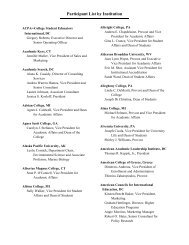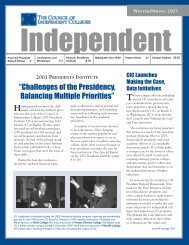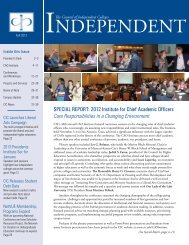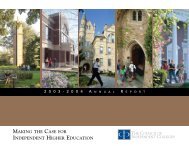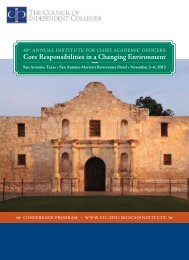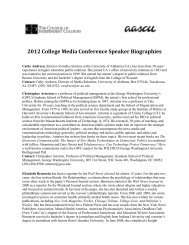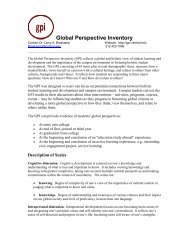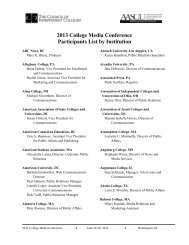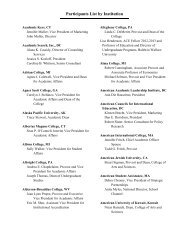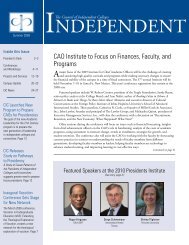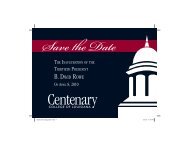Meeting the Challenge: - The Council of Independent Colleges
Meeting the Challenge: - The Council of Independent Colleges
Meeting the Challenge: - The Council of Independent Colleges
Create successful ePaper yourself
Turn your PDF publications into a flip-book with our unique Google optimized e-Paper software.
Small by Design: Resilience in an Era <strong>of</strong> Mass Higher Education<br />
By <strong>the</strong> early 1960s undergraduates were persistently complaining<br />
about what <strong>the</strong>y called <strong>the</strong> “impersonality <strong>of</strong> <strong>the</strong> multiversity.”<br />
that a residential campus experience combined with small<br />
class sizes and close teacher-student interaction represents a<br />
highly effective approach to undergraduate education.<br />
Not only is this educational philosophy effective,<br />
but studies by Astin and o<strong>the</strong>rs show that it is also relatively<br />
efficient. A high percentage <strong>of</strong> undergraduates at small<br />
colleges tended to continue beyond <strong>the</strong> freshman year<br />
and <strong>the</strong>n complete <strong>the</strong>ir degrees in four years. In contrast,<br />
<strong>the</strong> retention rate at public colleges and universities is<br />
considerably lower, and taking five or even six years to<br />
complete <strong>the</strong> bachelor’s degree has become increasingly<br />
typical. Over <strong>the</strong> years, large state universities have<br />
acknowledged <strong>the</strong>ir own problems about declining<br />
educational efficiency and effectiveness. By <strong>the</strong> early 1960s<br />
undergraduates were persistently complaining about<br />
what <strong>the</strong>y called <strong>the</strong> “impersonality <strong>of</strong> <strong>the</strong> multiversity.”<br />
As sociologists Christopher Jencks and David Riesman<br />
noted in <strong>The</strong> Academic Revolution (1968): “<strong>The</strong>re are no<br />
public Amhersts, Swarthmores, or Oberlins.” <strong>The</strong> implicit<br />
message was that independent colleges continued to serve<br />
an important role. Psychologist Nevitt Sanford’s pioneering<br />
1962 study <strong>of</strong> college students, <strong>The</strong> American College: A<br />
Psychological and Social Interpretation <strong>of</strong> Higher Learning, also<br />
warned about <strong>the</strong> growing student dissatisfaction with mass<br />
undergraduate education in large institutions. <strong>The</strong> small<br />
independent colleges were (and are) an exception to this<br />
general trend.<br />
While independent colleges were effective at<br />
educating and graduating students during <strong>the</strong> 1950s and<br />
1960s, <strong>the</strong>y were also innovating and expanding. Contrary<br />
to some popular notions, <strong>the</strong>re was institution-building<br />
in <strong>the</strong> private sector. Between 1949 and 1965 <strong>the</strong> historic<br />
Claremont <strong>Colleges</strong> in California added Claremont Men’s<br />
College (later Claremont McKenna College), Harvey Mudd<br />
College, and Pitzer College to <strong>the</strong>ir distinctive arrangement,<br />
popularly praised as <strong>the</strong> “Oxford <strong>of</strong> <strong>the</strong> Orange Belt.” In<br />
western Massachusetts, Hampshire College opened in<br />
1964—<strong>the</strong> harmonious product <strong>of</strong> cooperation among<br />
Amherst, Mount Holyoke, Smith, and <strong>the</strong> University <strong>of</strong><br />
Massachusetts. <strong>The</strong> unique “Great Books” curriculum at<br />
St. John’s College in Annapolis, Maryland was sufficiently<br />
attractive and successful that in <strong>the</strong> 1960s <strong>the</strong> college’s<br />
trustees created a second campus in Santa Fe, New Mexico.<br />
<strong>Independent</strong> colleges avoided complacence and embraced<br />
thoughtful reform in <strong>the</strong> 1960s. A Carnegie Corporation<br />
study by Morris Keeton and Conrad Hilberry, Struggle<br />
and Promise: A Future for <strong>the</strong> <strong>Colleges</strong> (1969), commended<br />
such colleges as Earlham, Morehouse, Simmons, Oberlin,<br />
Amherst, Berea, and Wheaton (MA) for <strong>the</strong>ir intensive selfstudies<br />
and institutional adaptations.<br />
16



